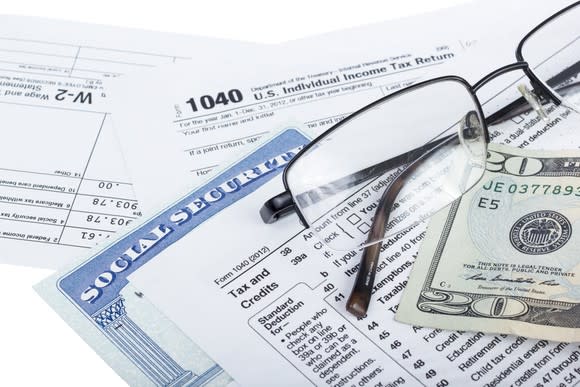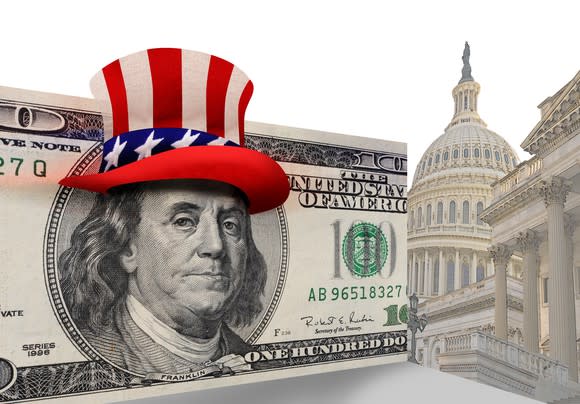This 34-Year-Old Social Security Rule May Be Hurting Nearly 24 Million Seniors
For millions of Americans, Social Security is more than just a paycheck they'll receive each month once they get older -- it's a vital source of income that they simply couldn't make do without. According to the Social Security Administration, more than three out of five elderly retirees currently receiving benefits leans on the program for at least half of their monthly income. That's what I'd call an indispensable social program.
Yet, this critical program is in pretty deep trouble. The latest report from the Social Security Board of Trustees predicts that it'll begin paying out more in benefits than it's generating in revenue by 2022. Just 12 years later, in 2034, nearly $3 trillion in asset reserves will be completely depleted.

Image source: Getty Images.
While some folks have worried that the exhaustion of this excess cash would mean the end of Social Security, it won't. The payroll tax, which is paid by working Americans, ensures that Social Security can't go bankrupt. But the elimination of Social Security's asset reserves could pave the way for substantial cuts to current and future retirees' benefits of up to 23%. Not exactly the rosiest forecast.
But there may be even more pressing concerns for elderly beneficiaries, such as the 34-year-old Social Security rule that could be wreaking havoc on nearly 24 million seniors.
There's no escaping Uncle Sam
In 1983, under the Reagan administration, the Social Security Amendments of 1983 were signed into law. These Amendments were necessary, with the program facing an at the time long-term actuarial deficit of around 1%, and they included a combination of new channels to raise revenue, as well as ways to cut benefits, over the long run.
Under the Amendments of 1983, the payroll tax was to be gradually raised for all working Americans, while the full retirement age would be increased by two years over a four-decade span. Your full retirement age is when you become eligible to receive 100% of your retirement benefit. But it's the introduction of the taxation of benefits that's left the biggest impression on seniors' Social Security checks.
To generate more revenue, Congress's Amendments included a provision that allowed the Internal Revenue Service to impose ordinary federal income tax on 50% of a taxpayer's Social Security benefits if he or she surpassed $25,000 in adjusted gross income (AGI), or $32,000 if it was a couple filing jointly. In 1993, under the Clinton administration, a second tier was added that exposed 85% of Social Security benefits to federal income tax if AGI was higher than $34,000 for a single filer or $44,000 as a couple filing jointly.

Image source: Getty Images.
When this rule was implemented in 1983, it was designed to tax about one out of every 10 households, and thus only applied to wealthier elderly recipients. But there's a pretty big catch to this Social Security rule: The income thresholds haven't been adjusted for inflation since the amendments were signed into law on April 20, 1983. That means while Social Security payouts and incomes have grown over time, the threshold has not, allowing more folks to become susceptible to having their Social Security benefits taxed.
According to a survey from The Senior Citizens League (TSCL), 56% of senior households receiving Social Security benefits as of 2015 were paying some level of federal tax on those benefits. Understandably, there may be more than a single elderly recipient in each household, but in a worst-case scenario, and with 42.3 million seniors receiving a benefits check each month as of October 2017, we could be looking at nearly 24 million seniors paying some form of Social Security tax.
This rule is crushing middle-income seniors and families
Not adjusting this income threshold for 34 years is hurting seniors in two ways.
First (and obviously), it's taking income out of the pockets of middle-class seniors and families who probably need it the most during retirement. While this tax is undoubtedly hitting some well-to-do seniors who aren't reliant on Social Security in any way, at least some of these taxed seniors are likely among the more than three out of five who rely on Social Security for at least half of their monthly income. Not adjusting this threshold for inflation is only going to continue to hurt middle- and perhaps even lower-income elderly beneficiaries.

Image source: Getty Images.
The second issue that's affecting seniors is the loss of purchasing power for Social Security dollars. Since 2000, TSCL has found that benefits have lost 30% of their purchasing power, mainly as a result of higher medical care and housing inflation. In other words, what once bought $100 worth of goods and services in 2000 now buys about $70 worth of goods and services.
Therefore, not only are seniors seeing their purchasing power reduced because Social Security's cost-of-living adjustments aren't keeping pace with the actual inflation they're facing, but their payouts are being reduced by the taxation of Social Security benefits from a rule that hasn't been adjusted for inflation in 34 years. That's quite the double-whammy.
Don't expect an update to this income threshold anytime soon
However, the ultimate slap in the face just might be that Congress has next to no incentive to update the income threshold associated with the taxation of benefits. While it would immediately help millions of seniors who rely on Social Security income to make ends meet each month, it would also reduce the amount of income the program generates each year.

Image source: Getty Images.
In 2016, taxing Social Security benefits generated $32.8 billion in revenue, or about 3.4% of the $957.5 billion in revenue for the program. Updating the threshold for inflation over the past 34 years, or removing the taxation of benefits entirely, would put more money in seniors' pockets, but it'd leave the program even shorter on cash than it already is. It's possible the asset reserve depletion date could be pushed forward without the revenue generated by the taxation of benefits.
Thus we have yet another dilemma for Capitol Hill to address: Adjust this archaic rule for inflation and burn through Social Security's asset reserves a tad quicker, or continue to siphon money out of the pockets of middle-income seniors?
More From The Motley Fool
6 Years Later, 6 Charts That Show How Far Apple, Inc. Has Come Since Steve Jobs' Passing
Why You're Smart to Buy Shopify Inc. (US) -- Despite Citron's Report
The Motley Fool has a disclosure policy.

 Yahoo Finance
Yahoo Finance 